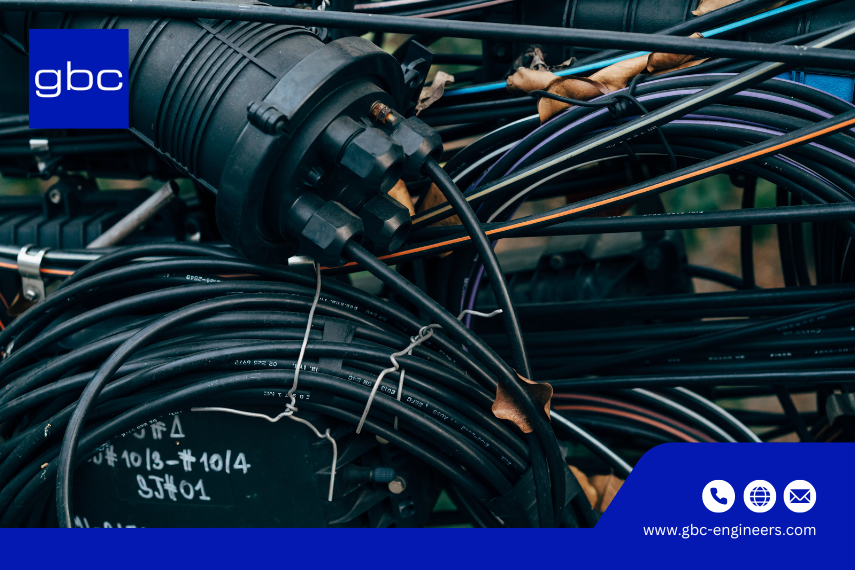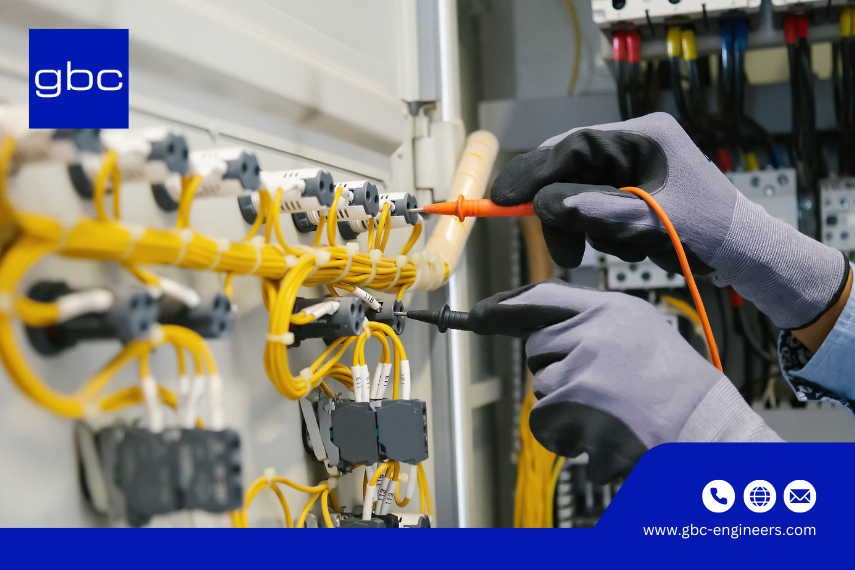Data centers are the backbone of modern digital infrastructure, providing secure, high-performance environments for critical IT equipment. Electrical distribution systems in data centers play a pivotal role in ensuring that power is delivered efficiently, safely, and reliably to meet the demanding needs of IT operations. These systems, while often appearing similar on the surface, have significant differences in their design, configuration, and capabilities, each suited to specific operational needs and energy requirements.
Understanding the terminology and components of data center electrical systems is crucial for IT professionals and electrical engineers. Common terms like high voltage, medium voltage, low voltage, and equipment such as switchgear, switchboards, panelboards, power distribution units (PDUs), and uninterruptible power supplies (UPS) can be confusing.
This guide explores these key components, their functions, placement, and relevant standards in data center electrical design, providing a deeper understanding of how power is distributed from the utility grid to the IT loads within a data center.
Learn about the key components and best practices in electrical data center design with gbc engineers. Discover how to ensure reliable, scalable, and energy-efficient power distribution for high-performance data centers.
The Power Supply Chain in Data Centers
Most data centers rely on the municipal electric grid as their primary source of power. This grid supplies energy, which is then transformed onsite to meet the voltage and current needs of the data center's IT systems. In addition to the municipal grid, many data centers incorporate backup generators to maintain continuity during grid failures or interruptions. These generators can supplement the primary power source or act as a fail-safe in case of power loss.
Power delivered to a data center undergoes several stages of transformation and distribution. Upon entering the facility, power is directed to Main Distribution Boards (MDBs), from which it is distributed to various systems like UPS units, load banks, and IT equipment. This process ensures that sensitive systems are shielded from power surges or interruptions, maintaining operational uptime and preventing potential damage to the equipment.
A key component in this setup is the Uninterrupted Power Supply (UPS) system. UPS systems provide a temporary power supply during disruptions, allowing enough time for backup generators to kick in and maintain smooth operations. These systems are crucial for protecting critical infrastructure, ensuring that even short power outages do not impact the data center's functionality or the businesses that depend on its services.
For more information on services, privacy, and management of data center power systems, please feel free to contact us or explore our projects.
Key Components of Data Center Electrical Distribution Systems
1. Medium-Voltage Switchgear and MV/LV Transformers
Role in Power Distribution: Medium-voltage switchgear plays a crucial role in large-capacity data centers, particularly those with more than 1 MW IT load. It marks the entrance of utility power into the building and is essential in controlling and distributing electricity to the data center's internal infrastructure.
If the data center uses a medium-voltage generator, the switchgear also connects the generator to the electrical network, ensuring that power is available to support operations even during an outage.
Key Equipment: The MV switchgear is equipped with several critical components, such as meters, breakers, contactors, fuses, surge arresters, voltage/current transformers, and control relays. These elements are essential for protecting the data center’s architecture by disconnecting faults, isolating sections for maintenance, and ensuring safe and efficient power flow to the servers and other IT hardware. The power distribution network relies on this equipment to maintain the stability and integrity of data center power.
Configuration: The switchgear is typically composed of multiple cubicles, including an incoming unit, outgoing unit, voltage metering unit, and bus section. Each cubicle is designed with safety in mind, featuring a single MV circuit breaker that handles high-voltage flows. This setup ensures the proper management of data center power and supports the operation of essential equipment without risk of overload or damage.
This infrastructure forms the backbone of data center power distribution, supporting critical services such as uninterrupted power supply (UPS), backup generators, and load management, ensuring that your servers and IT components always remain operational and secure. For more information on how we can support your data center power needs or to explore our services, contact us today.
2. Low-Voltage Switchgear/Switchboard and Automatic Transfer Switch (ATS)
Role in Power Distribution: Low-voltage switchgear is essential in data centers with lower power demands (less than 1 MW). It is responsible for controlling the power flow from the secondary side of the MV/LV transformer or from backup generators to the data center’s critical business equipment, ensuring that power reaches servers, cooling systems, and other essential IT infrastructure. Efficient power distribution is key to maintaining operations and achieving optimal power usage effectiveness (PUE), a metric that is crucial for measuring energy efficiency in data centers.
Key Equipment: Low-voltage switchgear includes various components like incoming feeders, power control centers (PCC), motor control centers (MCC), busbars, circuit breakers, meters, surge arresters, and relays. These devices are integral to the reliable and safe distribution of power within the data center.
They also provide protection against faults and overcurrent situations, minimizing risks that could disrupt operations. Ensuring proper functionality of this equipment supports both business continuity and energy efficiency, aligning with best practices for power management.
Power Parameters: The power potential and current ratings of LV switchgear are critical to its performance. Typically, power potential ratings for LV switchgear range from 690V, with lightning impulse withstand power potentials up to 12kV. Current ratings are tailored to meet the system’s requirements and adhere to local standards, ensuring that the power infrastructure supports the data center’s operational needs without compromising reliability or safety.

For businesses looking to enhance their power usage effectiveness and ensure the optimal management of their data center power systems, choosing the right equipment and configuration is essential. For further details or to inquire about our services, please feel free to contact us. All rights reserved.
3. Uninterruptible Power Supply (UPS) Systems
Role in Power Protection: UPS units are central to maintaining uninterrupted power supply to critical IT infrastructure during power interruptions. These solutions are designed to handle sudden power surges, short outages, and provide enough time for backup generators to take over.
Types of UPS Configurations: Depending on the data center's needs, UPS setups can vary in configuration. Typically, these arrangements include UPS input/output switchboards, UPS distribution switchboards, and static transfer switches (STS) for bypass functions.
Reliability Considerations: UPS design configurations are essential for ensuring that critical IT equipment remains operational. Choosing the appropriate UPS layout is a key decision in the electrical design process.
4. Power Distribution Units (PDUs) and Remote Power Panels (RPPs)
Role in Power Distribution: PDUs and RPPs are used in data centers to distribute power from the upstream UPS units to IT racks and other critical loads. They control, monitor, and protect the power flowing to these components.
Key Equipment: A typical PDU includes a main input circuit breaker, branch circuit panelboards, power transformers, surge arrestors, and monitoring and communication modules. PDUs are typically rated for power requirements ranging from 50 kW to 500 kW.
Types of PDUs: PDUs come in several variations depending on geographical requirements. For example, in North American data centers, PDUs may step down power from 480V to 120/208V, while in Japan, they may step down power from 200V to 100V.
5. Busway Systems
Role in Power Distribution: Busway assemblies offer an alternative to traditional PDUs and RPPs by providing modular, flexible electrical distribution. They consist of a feed unit, power bus, plug-in units (with overcurrent protection devices), and connections.
Advantages: Busways can be mounted overhead or under the floor, depending on the layout of the data center. The system provides flexibility for future upgrades and reconfigurations while minimizing downtime during maintenance.
Use Case: Busways are particularly useful in large-scale data centers requiring modular power distribution solutions.
Read More: Everything You Need to Know: Hyperscale Infrastructure in 2025 - gbc engineers
6. Panelboards
Role in Power Distribution: Panelboards are typically used in the mechanical, power, and IT spaces of a data center. They distribute energy to cooling equipment, lighting, security infrastructure, and other essential components.
Key Equipment: Panelboards house the main power busbars and terminals, where circuit breakers, neutral wires, and ground wires are installed. They are typically wall-mounted and designed for ease of access and maintenance.
7. Rack Power Distribution Units (rPDUs)
Role in Power Distribution: Rack PDUs, often referred to as power strips, are mounted in IT racks and provide power directly to the IT equipment in those racks. They are powered by upstream PDUs or RPPs and can be configured for either single-phase or three-phase power distribution.
Features: rPDUs often include features like surge protection, metering, and monitoring, which are essential for tracking power usage and ensuring that racks are powered efficiently and safely.

Read More: What Are the Essential Components of a Data Center Facility? - gbc engineers
Best Practices for Data Center Electrical Design
Redundancy and Reliability: One of the most critical aspects of data center power infrastructure design is ensuring that the infrastructure is fault-tolerant and capable of maintaining operations during power outages. Using redundant UPS setups, dual power feeds from the utility grid, and backup generators are essential for achieving this reliability.
Scalability: As data centers grow, their power requirements increase. It’s important to design the power infrastructure with scalability in mind, allowing for easy upgrades and expansion of the system.
Energy Efficiency: Reducing energy consumption is a key objective in modern data center design. The use of energy-efficient transformers, UPS units, and power infrastructure components can significantly lower operational costs and reduce the data center's environmental footprint.
Compliance with Standards: Compliance with international standards like IEC, ANSI, and the National Electrical Code (NEC) is crucial for ensuring safety, reliability, and performance. Data center power designs must meet these benchmarks to ensure legal compliance and best practices.
Continuous Monitoring and Maintenance: Regular monitoring of power infrastructure components, along with preventative maintenance, is essential for ensuring the continued operation and reliability of the data center’s power system.

Read More: What Are Data Center Solutions? A Comprehensive Overview - gbc engineers
Ready to Future-Proof Your Data Center?
Partner with gbc engineers to design a facility that delivers performance, reliability, and long-term value.
🌐 Visit: www.gbc-engineers.com
🏗️ Explore Our Services: Services - gbc engineers
Conclusion
Electrical data center design is a complex but critical task that requires a deep understanding of power flow, safety, and reliability. By integrating the right mix of equipment—such as medium-voltage switchgear, UPS systems, PDUs, and backup generators—data centers can ensure uninterrupted service and safeguard critical IT operations.
Incorporating redundancy, scalability, energy efficiency, and adherence to industry standards will further enhance the performance and longevity of the data center’s electrical infrastructure, helping businesses maintain the high availability and reliability that are fundamental to modern data operations.
By focusing on high efficiency, security, and reliability, gbc engineers ensure that each data center design is tailored to meet the specific needs of the client, whether they are operating from the cloud or using high-density computing systems.
Through careful planning and the use of advanced power distribution solutions, businesses can create efficient and scalable data center operations capable of handling the demands of modern IT workloads.